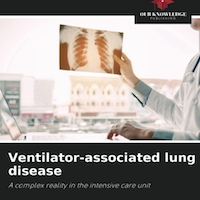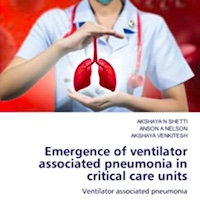Tag: VAP
Endotracheal Tube Cuff Pressure Monitoring and VAP Occurrence
This study demonstrated that maintaining endotracheal tube cuff pressure at 30 cm H2O through monitoring every 8 h did not result in a greater incidence of under-inflation (pressures ... read more
Inadequate Empirical Antibiotic Therapy in VAP: Risk Factors and Outcomes
Ventilator-associated pneumonia (VAP) caused by MDR pathogens were highly likely to receive inadequate empirical antibiotic therapy. The mortality rate and intubation duration were significantly longer in inadequately treated... read more
Serum MANF vs. Severity and Prognosis in Community-acquired Pneumonia Patients
This evidence demonstrated that serum mesencephalic astrocyte-derived neurotrophic factor (MANF) is positively associated with scoring criteria and poor prognosis in community-acquired pneumonia (CAP) patients. Serum... read more
Holy Water Not so Holy: Potential Source of Elizabethkingia Pneumonia and Bacteremia in an Immunocompromised Host
This case report highlights that E. anophelis may indeed cause significant infection and should not be considered a contaminant especially in immunosuppressed individuals. The organism originates from water sources and may... read more
Ventilator-associated Pneumonia Pathogenesis: Old and New Mechanisms
Ventilator-associated pneumonia (VAP), defined as a lung infection that occurs in patients after 48 hours on mechanical ventilation, is among the most frequently found nosocomial infections in intensive care units around... read more
VAP Recurrences Definition: European Experts Consensus
This consensus by European experts proposes four different ventilator-associated pneumonia (VAP) recurrence entities which should facilitate the harmonization of recurrence criteria for clinical practice and future studies. Thirty-six... read more
Successful Clearance of Persistent Staphylococcus Aureus Pneumonia Using High-dose Continuous Infusion Cefazolin
High-dose cefazolin (10 g daily), given as a continuous infusion (CI), was able to clear community-acquired methicillin-susceptible Staphylococcus aureus (MSSA) pneumonia while not exhibiting any signs of toxicity or adverse... read more
VAP in Patients with Increased Intra-abdominal Pressure
Critically ill patients with increased intra-abdominal pressure (IAP) and multidrug-resistant (MDR) ventilator-associated pneumonia (VAP) are considered a challenging patient population in every ICU setting. Patients with... read more
Prophylactic IV Antibiotics Outcomes in Patients with Acute Severe Brain Injury on Mechanical Ventilation
Among critically ill patients with acute brain injury, prophylactic IV antibiotics were associated with less VAP but not with changes in length of stay, mortality, or neurologic outcomes. Patients with structural brain... read more
Oral Health Care and VAP in ICU Patients
Both Zataria Multiflora (ZM) and Chlorhexidine (CHG) and CHG alone reduce ventilator-associated pneumonia (VAP) incidence and improve the oral health status of mechanically ventilated patients. However, the combination of... read more
Antibiotic Prophylaxis Effectiveness in Polytrauma Patients
The results indicate that antibiotic prophylaxis has no significant effect on mortality and clinical status compared with placebo or standard care in adult polytrauma patients but may reduce the risk of VAP. However,... read more
Ventilator Associated Pneumonia in ICU: Identification, Evaluation and Prevention
This study highlights the significant prevalence of Pseudomonas aeruginosa (PA) as a major bacterial pathogen causing ventilator-associated pneumonia (VAP) in ICU patients, with a high detection rate of 71.7% in tested patients,... read more
Prolonged vs. Intermittent Infusion of Meropenem For Patients with Severe Infection
Prolonged infusion of meropenem is more effective than intermittent infusion in reducing mortality, improving clinical outcomes, and enhancing microbial eradication, without increasing adverse events. These benefits are... read more
New Insights on CRRT for ARDS
In recent times, the applications of continuous renal replacement therapy (CRRT) beyond kidney‐related conditions have been progressively increasing, and its implementation in randomized controlled trials (RCTs) specifically... read more
Single-use vs. Multiple-use Endotracheal Suction Catheters Flushed with Chlorhexidine in Mechanically Ventilated ICU Patients
The aim of this feasibility randomized controlled trial (fRCT) is to assess the practicality and impact of using single-use versus multiple-use endotracheal suction catheters flushed with chlorhexidine on the incidence of... read more
Mechanical Ventilator-Associated Pneumonia in the COVID-19 Pandemic Era
The most common pathogens isolated in our ventilator-vssociated pneumonia (VAP) patients were Acinetobacter spp., Pseudomonas aeruginosa, Klebsiella pneumoniae, and Staphylococcus aureus. Resistance to the major classes... read more
Ventilator-associated Lung Disease: A Complex Reality in the ICU
Mechanical ventilation, by tracheal intubation or tracheostomy, is the common supplementary treatment for several reasons for hospitalization. Since the advent of long-term mechanical ventilation during the polio epidemic. In... read more

Emergence of Ventilator Associated Pneumonia in Critical Care Units
In intensive care unit, the care of critically ill patients is a primary component of modern medicine. Intensive care units create potential for recovery in patients who otherwise may not have survived. They are, however,... read more

Early Tracheostomy in Ventilated COVID-19 Patients Reduces VAP Incidence
Tracheostomy can reduce mechanical ventilation (MV) duration, ICU and hospital length of stay (LOS), and ventilator-associated pneumonia (VAP) risk in critically ill patients. The timing of tracheostomy in COVID-19 patients... read more
Preventing VAP Non-Pharmacologically
In critically ill, intubated patients on intensive care unit (ICU), ventilator-associated pneumonia (VAP) is a significant complication contributing to substantial mortality, morbidity, and prolonged stays, which in turn... read more
A Retrospective Closed Cohort Study on Distribution of Multidrug-Resistant Bacteria in VAP and its Impact on Patient Outcome
Gram-negative organisms, particularly Klebsiella and Acinetobacter, were the main multidrug-resistant (MDR) ventilator-associated pneumonia (VAP) culprits. MDR-VAP exhibited higher morbidity and mortality. A study... read more
Tele-ICU Rounds Ineffective in Shortening ICU Stay for Patients
Daily multidisciplinary rounds conducted by a board-certified intensivist through telemedicine do not reduce intensive care unit (ICU) length of stay (LOS) in critically ill adult patients, according to a study published... read more









